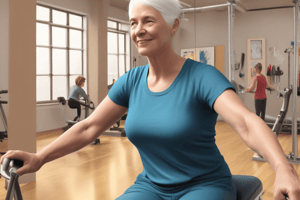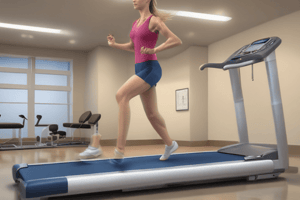Podcast
Questions and Answers
Which reactive balance test scores on a 9-point scale?
Which reactive balance test scores on a 9-point scale?
- Weight displacement test
- Sternal rub test
- Nudge test
- Postural stress test (correct)
When should the stopwatch be started during the timed up and go test?
When should the stopwatch be started during the timed up and go test?
- When the client is in the full standing position
- On the signal to go (correct)
- As the client leans forward in the chair
- When the client first rises up from a seated position
Is the star excursion balance test a measure of dynamic balance that provides significant challenges to athletes?
Is the star excursion balance test a measure of dynamic balance that provides significant challenges to athletes?
- True (correct)
- False
Which test battery is scored on a scale ranging from 0 to 2 and contains 14 performance-based items?
Which test battery is scored on a scale ranging from 0 to 2 and contains 14 performance-based items?
What is the purpose of the limits of stability test?
What is the purpose of the limits of stability test?
Which statement regarding tai chi and balance is NOT correct?
Which statement regarding tai chi and balance is NOT correct?
How many days per week does the ACSM recommend performing neuromotor exercises to help reduce falls?
How many days per week does the ACSM recommend performing neuromotor exercises to help reduce falls?
Which test battery is widely used to evaluate balance performance of older adults in nursing homes and community settings?
Which test battery is widely used to evaluate balance performance of older adults in nursing homes and community settings?
Flashcards are hidden until you start studying
Study Notes
Reactive Balance Tests
- The postural stress test scores on a 9-point scale, evaluating balance under stress.
Timed Up and Go Test
- Stopwatch should be started on the signal to go, marking the beginning of the assessment.
Star Excursion Balance Test
- This test measures dynamic balance and significantly challenges athletes and active individuals; it is a true statement.
Tinetti Performance-Oriented Mobility Assessment (POMA)
- Contains 14 performance-based items scored on a scale ranging from 0 to 2, widely used for assessing mobility.
Limits of Stability Test
- Measures maximum excursion of the center of gravity, assessing balance while leaning in multiple directions.
Tai Chi and Balance
- Incorrect statement: The Chen style of tai chi is not necessarily the most popular for older adults; other styles may be more favored.
- Tai chi is shown to help reduce falls and improve balance in older adults; significant improvement typically requires at least 40 sessions over 15 weeks.
ACSM Recommendations for Neuromotor Exercises
- It is recommended to perform neuromotor exercises involving balance, agility, coordination, and gait two to three days per week to help reduce falls.
Berg Balance Scale
- Widely used to evaluate the balance performance of nursing home residents and community-dwelling older adults.
Gait Velocity Test
- Correct statement: Individuals who stop walking while talking are at a significantly increased risk of falls.
- Older adults with a history of falls typically demonstrate slower gait velocities compared to those without such history.
Studying That Suits You
Use AI to generate personalized quizzes and flashcards to suit your learning preferences.




